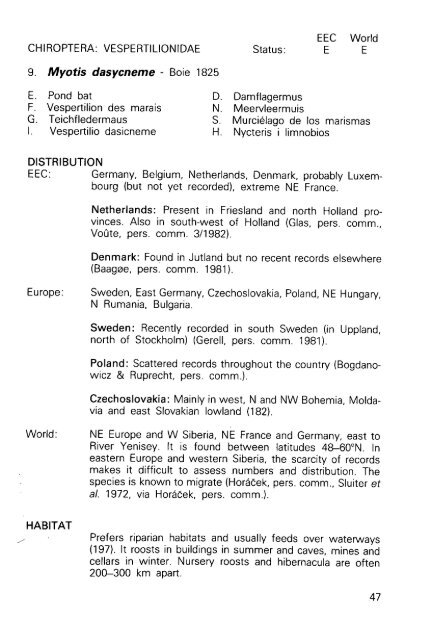kf 7 - NERC Open Research Archive - Natural Environment Research
kf 7 - NERC Open Research Archive - Natural Environment Research
kf 7 - NERC Open Research Archive - Natural Environment Research
You also want an ePaper? Increase the reach of your titles
YUMPU automatically turns print PDFs into web optimized ePapers that Google loves.
DISTRIBUTION<br />
EEC: Germany, Belgium, Netherlands, Denmark, probably Luxembourg<br />
(but not yet recorded), extreme NE France.<br />
HABITAT<br />
Netherlands: Present in Friesland and north Holland provinces.<br />
Also in south-west of Holland (Glas, pers. comm.,<br />
Voûte, pers. comm. 3/1982).<br />
Denmark: Found in Jutland but no recent records elsewhere<br />
(Baagoe, pers. comm. 1981).<br />
Europe: Sweden, East Germany, Czechoslovakia, Poland, NE Hungary,<br />
N Rumania, Bulgaria.<br />
Sweden: Recently recorded in south Sweden (in Uppland,<br />
north of Stockholm) (Gerell, pers. comm. 1981).<br />
Poland: Scattered records throughout the country (Bogdanowicz<br />
& Ruprecht, pers. comm.).<br />
Czechoslovakia: Mainly in west, N and NW Bohemia, Moldavia<br />
and east Slovakian lowland (182).<br />
World: NE Europe and W Siberia, NE France and Germany, east to<br />
River Yenisey. It is found between latitudes 48-60°N. In<br />
eastern Europe and western Siberia, the scarcity of records<br />
makes it difficult to assess numbers and distribution. The<br />
species is known to migrate (Horkek, pers. comm., Sluiter et<br />
al. 1972, via Horkek, pers. comm.).<br />
Prefers riparian habitats and usually feeds over waterways<br />
(197). It roosts in buildings in summer and caves, mines and<br />
cellars in winter. Nursery roosts and hibernacula are often<br />
200-300 km apart.<br />
47

















